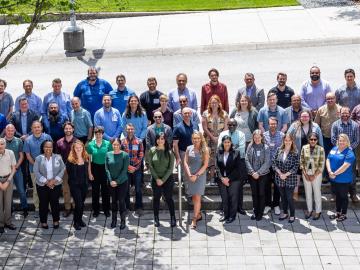
Filter News
Area of Research
- Biology and Environment (102)
- Biology and Soft Matter (1)
- Clean Energy (129)
- Climate and Environmental Systems (6)
- Computational Engineering (1)
- Computer Science (3)
- Electricity and Smart Grid (1)
- Energy Sciences (1)
- Fuel Cycle Science and Technology (1)
- Functional Materials for Energy (2)
- Fusion and Fission (5)
- Isotopes (3)
- Materials (51)
- Materials for Computing (6)
- Mathematics (1)
- National Security (40)
- Neutron Science (16)
- Nuclear Science and Technology (1)
- Supercomputing (41)
News Topics
- (-) Climate Change (101)
- (-) Energy Storage (109)
- (-) Environment (196)
- (-) National Security (65)
- 3-D Printing/Advanced Manufacturing (124)
- Advanced Reactors (34)
- Artificial Intelligence (94)
- Big Data (57)
- Bioenergy (92)
- Biology (100)
- Biomedical (59)
- Biotechnology (22)
- Buildings (57)
- Chemical Sciences (66)
- Clean Water (30)
- Composites (28)
- Computer Science (192)
- Coronavirus (46)
- Critical Materials (27)
- Cybersecurity (35)
- Decarbonization (80)
- Education (4)
- Element Discovery (1)
- Emergency (2)
- Exascale Computing (38)
- Fossil Energy (6)
- Frontier (43)
- Fusion (55)
- Grid (65)
- High-Performance Computing (87)
- Hydropower (11)
- Irradiation (3)
- Isotopes (53)
- ITER (7)
- Machine Learning (48)
- Materials (144)
- Materials Science (141)
- Mathematics (9)
- Mercury (12)
- Microelectronics (3)
- Microscopy (51)
- Molten Salt (8)
- Nanotechnology (60)
- Net Zero (14)
- Neutron Science (131)
- Nuclear Energy (109)
- Partnerships (46)
- Physics (62)
- Polymers (33)
- Quantum Computing (35)
- Quantum Science (69)
- Renewable Energy (2)
- Security (24)
- Simulation (49)
- Software (1)
- Space Exploration (25)
- Statistics (3)
- Summit (58)
- Sustainable Energy (129)
- Transformational Challenge Reactor (7)
- Transportation (97)
Media Contacts
Joe Tuccillo, a human geography research scientist, leads the UrbanPop project that uses census data to create synthetic populations. Using a Python software suite called Likeness on ORNL’s high-performance computers, Tuccillo’s team generates a population with individual ‘agents’ designed to represent people that interact with other agents, facilities and services in a simulated neighborhood.

ORNL hosted the Mid-South Regional Chapter of the American Society for Photogrammetry and Remote Sensing, or ASPRS. Participants spanning government, academia and industry engaged in talks, poster sessions, events and workshops to further scientific discovery in a field devoted to using pictures to understand changes to the earth’s inhabitants and landscape.

To better predict long-term flooding risk, scientists at the Department of Energy’s Oak Ridge National Laboratory developed a 3D modeling framework that captures the complex dynamics of water as it flows across the landscape. The framework seeks to provide valuable insights into which communities are most vulnerable as the climate changes, and was developed for a project that’s assessing climate risk and mitigation pathways for an urban area along the Southeast Texas coast.

A newly established internship between ORNL and Maryville College is bringing cybersecurity careers to a local liberal arts college. The internship was established by a Maryville College alumni who recently joined ORNL.

In the wet, muddy places where America’s rivers and lands meet the sea, scientists from the Department of Energy’s Oak Ridge National Laboratory are unearthing clues to better understand how these vital landscapes are evolving under climate change.

As a data scientist, Daniel Adams uses storytelling to parse through a large amount of information to determine which elements are most important, paring down the data to result in the most efficient and accurate data set possible.

ORNL's Guang Yang and Andrew Westover have been selected to join the first cohort of DOE’s Advanced Research Projects Agency-Energy Inspiring Generations of New Innovators to Impact Technologies in Energy 2024 program. The program supports early career scientists and engineers in their work to convert disruptive ideas into impactful energy technologies.

Despite strong regulations and robust international safeguards, authorities routinely interdict nuclear materials outside of regulatory control. Researchers at ORNL are exploring a new method that would give authorities the ability to analyze intercepted nuclear material and determine where it originated.

Researchers at Oak Ridge National Laboratory have developed free data sets to estimate how much energy any building in the contiguous U.S. will use in 2100. These data sets provide planners a way to anticipate future energy needs as the climate changes.

When Oak Ridge National Laboratory's science mission takes staff off-campus, the lab’s safety principles follow. That’s true even in the high mountain passes of Washington and Oregon, where ORNL scientists are tracking a tree species — and where wildfires have become more frequent and widespread.


